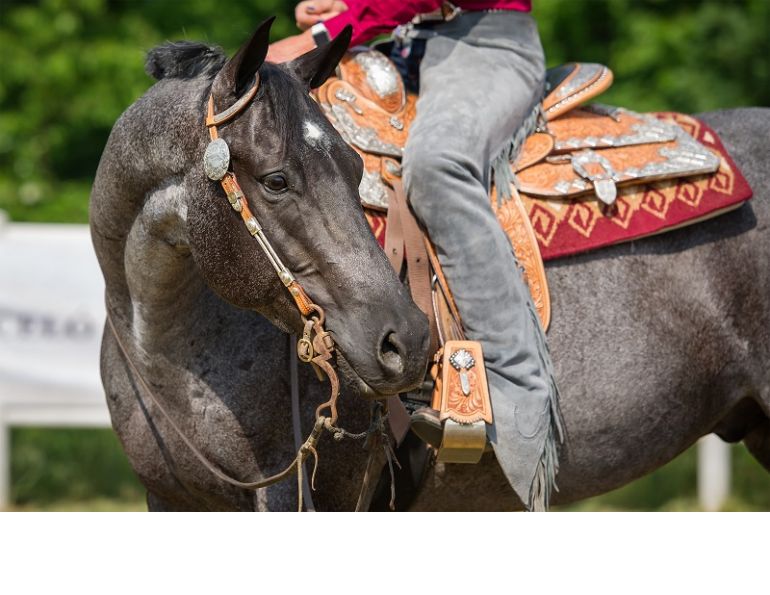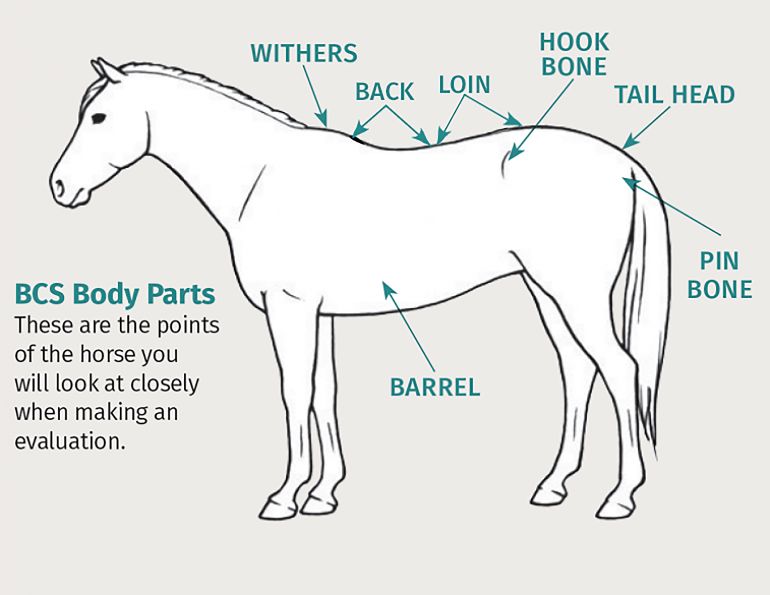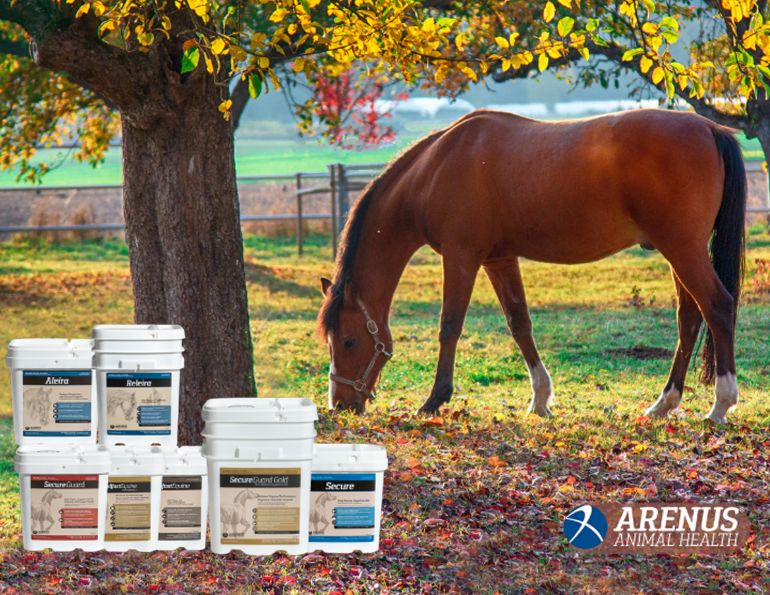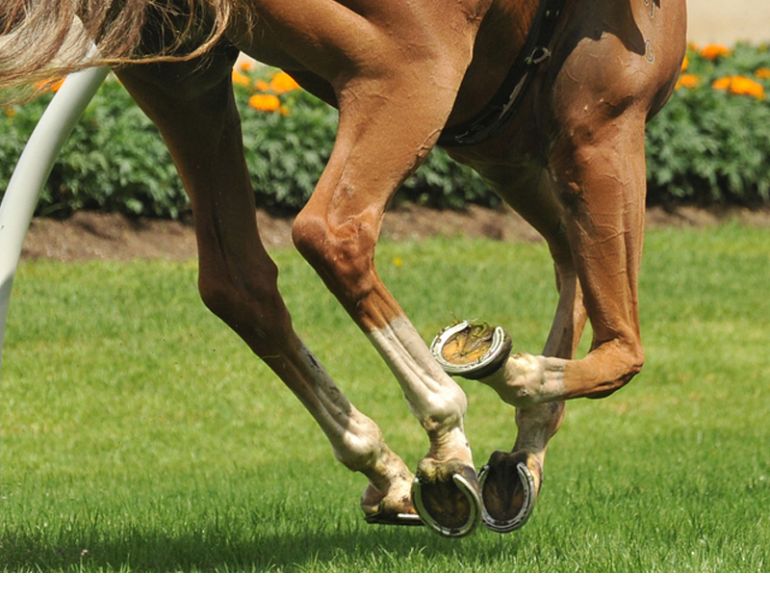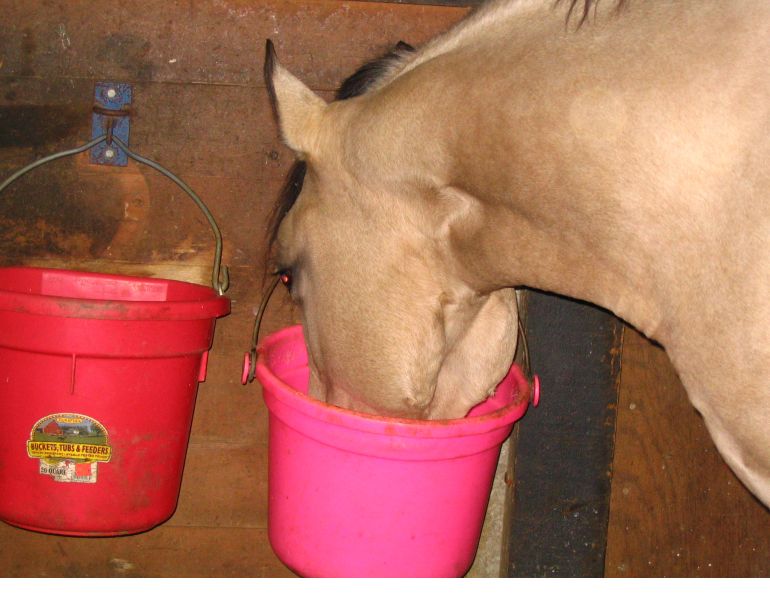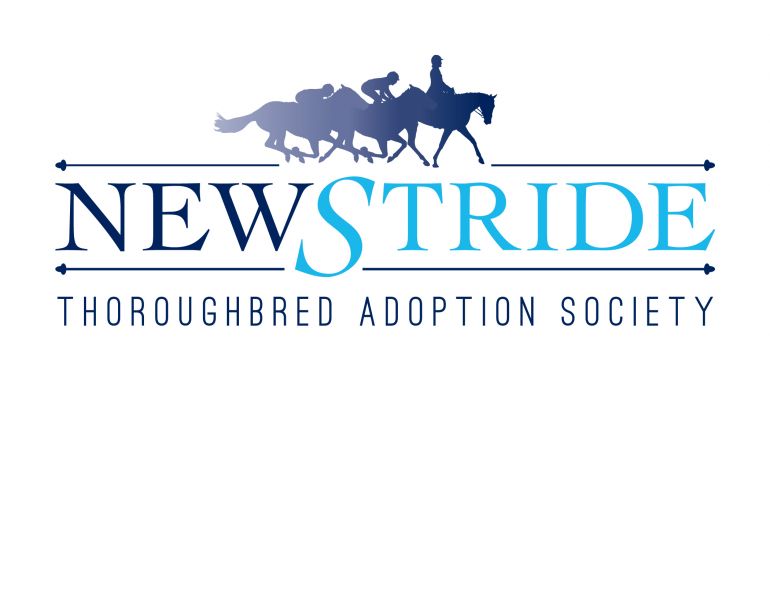By Shelagh Niblock, BSc.Ag., PAS
The past century has seen big changes in the role of horses in our society. Prior to World War I, horses were an essential part of our lives and were, quite literally, the “horse power” that turned the wheels of our economy. In the largely agrarian society of the day, horses were found everywhere in their capacity as beasts of burden. Horses 100 years ago worked for a living and were rarely ever obese, and frequently they did not live long after their functional life ceased.
In the 21st century, our horses no longer occupy the same roles. Today horses commonly serve as our companions and partners in sport and recreation. In general, our horses receive plentiful food and minimal activity, and consequently, we are seeing in them metabolic issues and diseases that were unheard of 100 years ago.
Some help for these problems may be found in a low starch diet.
Parallels between Human and Equine Health
The increase in the incidence of equine metabolic diseases such as Equine Metabolic Syndrome (EMS), Insulin Resistance (IR), and Pituitary Pars Intermedia Dysfunction (PPID or Cushing’s disease) is considered by many equine researchers to directly relate to the increasing number of senior, underactive, and overfed horses.

The equine digestive system is divided into the foregut (the esophagus, stomach, and small intestine) and the hindgut (cecum, large colon, and small colon).
We know that, as in human nutrition, not only are excess calories a problem for our horses, the type of calories consumed is also important. Many equine nutritionists and veterinarians are urging us to avoid starches and sugar in our horses’ diets, choosing instead diets consisting of fibre sources, such as good quality hay, with fat sources being used to increase energy intake if necessary.
Digestive Function
Horses are considered anatomically to be “non-ruminant herbivores” or “hindgut fermenters.” They have evolved on a diet of a variety of carbohydrates from simple sugars to more complex sugars and starches, and ultimately complex polysaccharides called fibre.
Simple carbohydrate sources such as the sugar and starch found in grains and fresh pasture grass are digested in the horse’s stomach and small intestine to become the primary carbohydrate, glucose. Glucose is essential for life and is absorbed through the wall of the small intestine into the bloodstream. Increasing blood glucose levels stimulates the pancreas to secrete a hormone called insulin. Insulin facilitates the transport of glucose out of the blood into the tissues of the animal, where it is either used immediately for energy for performance or growth, or stored as either glycogen or body fat for future energy use.
What about Fibre?
Fibre falls into the category of complex polysaccharides that cannot be digested by mammalian enzymes in the stomach and small intestine of the horse. Complex carbohydrates, including fibre sources such as hemicellulose, cellulose, and some complex sugars such as fructan polysaccharides and pectin, pass right through the foregut of the horse into the hindgut where the cecum and large intestine are located. Polysaccharides are fermented by the population of bacteria that live in the cecum and become substances called volatile fatty acids (VFA). VFAs move through the gut wall into the bloodstream where they are transported to the liver. The liver converts VFAs into glucose if the animal needs energy for work, growth, or other physiological requirements, or into body fat if no extra energy is required. Hindgut fermented carbohydrates are sometimes a safer source of energy for the metabolically challenged horse as they do not cause fluctuations in glucose or insulin levels.
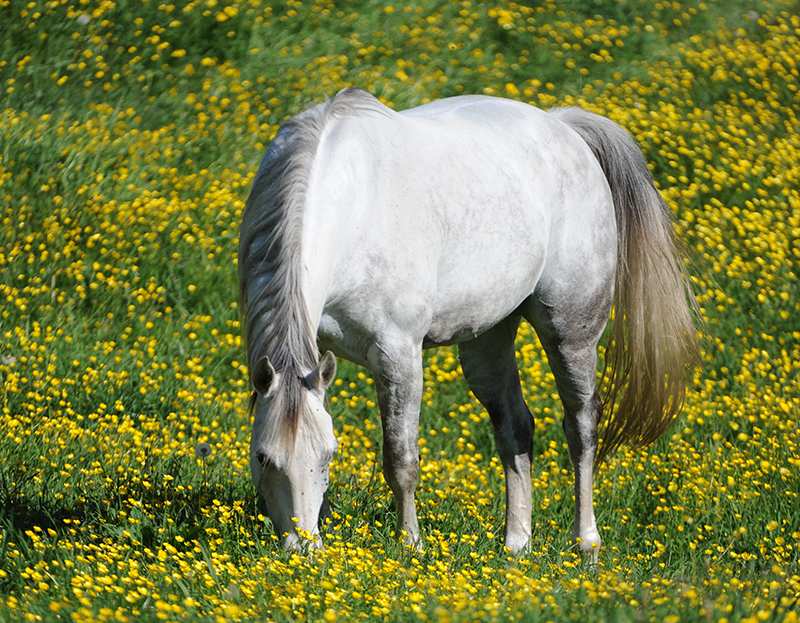
Fresh grass contains simple carbohydrate sources, such as sugar and starch. These are converted to glucose which stimulates the production of insulin, a potential problem in horses with metabolic disorders. Photo: Robin Duncan Photography
Why do some horses need low starch diets?
Large meals of high sugar or high starch feeds will result in a rapid increase in blood glucose in the horse. This in turn results in a compensatory increase in blood insulin levels. Horses with metabolic issues related to obesity, old age, or inactivity are much more likely to be insulin resistant, a condition in which increasing levels of blood insulin are required by the animal to regulate blood glucose levels. Animals that are insulin resistant are more likely to experience chronic laminitis or acute laminitic episodes as well as reduced immune function and other health issues. Insulin resistant horses do best when fed diets low in readily digestible carbohydrates such as starch.
There are other metabolic disease conditions for which low starch diets are necessary. Horses with Polysaccharide Storage Myopathy (PSSM) are actually unable to effectively store glucose in their cells to act as energy reserves. Horses with PSSM frequently have a normal glucose/insulin metabolic process but are genetically compromised so that when glucose is taken into the cell through the actions of insulin, it is stored in a molecular form that cannot be utilized by the muscle when energy is needed for work. These horses “hit the wall” when doing work because the muscle cannot metabolize the glucose stores (glycogen) for energy. These horses also do much better on low starch diets where energy is provided either through hindgut fermented carbohydrates such as pectin or cellulose, or through fat supplementation.
Is starch always bad?
Both starch and sugar are important energy sources for the high performance equine athlete and, when fed appropriately, they are not dangerous or “bad” for your horse, assuming that he is otherwise healthy. Carbohydrates such as starch should be fed in small amounts per meal so that the starch is digested before it moves out of the foregut. Excessive starch fermentation in the hindgut can cause deleterious changes in hindgut bacterial populations, potentially resulting in health problems such as gas colic, chronic and/or acute laminitic episodes, and hindgut ulcers, to name a few. Small meals ensure that starch is more likely to be digested in the small intestine and that fluctuations in blood glucose as a result of starch digestion are smaller and more efficiently regulated by the insulin secreted by the pancreas.
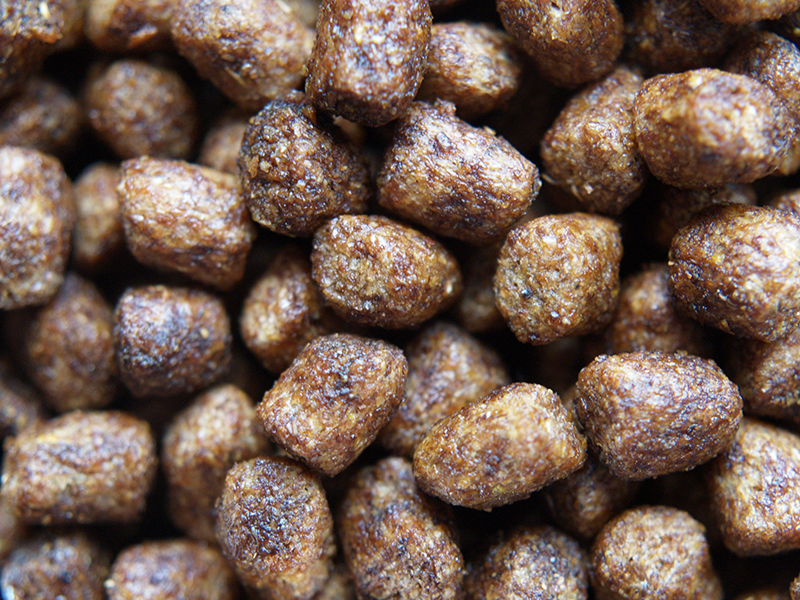
Processing methods, such as extrusion, can slow intake down, reducing the risk of spikes in blood glucose levels from the digestion of starch. Photo: Pam MacKenzie Photography
Starch processing can also have a significant impact on how well your horse handles starch in the diet. Processed starch, whatever the processing method (cooking, steam flaking, pelleting, grinding or extruding), can result in starch being broken down to glucose more readily in the stomach and small intestine.
The potential outcome of feeding processed feeds is a more rapid increase in blood glucose levels, reinforcing the need to feed your horse small meals, but it can also result in greatly reduced risk of undigested starch being pushing out of the stomach and into the hindgut where it can cause other problems. Processing methods, such as extrusion, that change the physical form of the feed can actually slow intake down, thereby reducing the risk of spikes in blood glucose from starch digestion.
Do growing horses need low starch diets?
Regardless of breed, growing horses have very clearly defined requirements for protein and energy as well as a number of other nutrients. The risks of Developmental Orthopedic Disease (DOD) are frightening for horse owners raising young horses, especially in some breeds where there is strong genetic predilection for stature and frame.
It is important to ensure that young, growing horses get sufficient protein, vitamins, and minerals in their daily feed intake without overfeeding energy. This can often be accomplished by offering young horses good quality hay; however, sometimes it is necessary to make up for a shortfall in the hay quality with a grower ration. Young horses are at some disadvantage once weaned as they have small body capacity and so can’t always eat enough forage to supply their nutrient needs unless offered sufficient good quality forage. Weanlings on a strictly hay diet should always be provided with a vitamin and mineral supplement formulated for growth.

Young horses have specific needs for protein, vitamin, and mineral intake, and often require a grower ration to supplement good quality hay.
Excessive starch intake by young horses can lead to increased body fat and it has been suggested by researchers that deposition of excessive body fat, in particular organ fat, early in life can lead to increased risk of insulin resistance down the road. Young horses fed energy in excess of their requirements will gain excessive weight and will be at risk of DOD.
How do I feed a low starch diet to my horse?
The most common low starch diet is one comprised of grass or grass/alfalfa hay, and salt, water, and a mineral supplement. It is important to ensure that your grass hay is not excessively high in water soluble carbohydrates (WSC) or correspondingly in ethanol soluble carbohydrates (ESC) or simple sugars. Feeding high sugar hay can have just as significant an impact on the glucose/insulin metabolism in a horse as feeding high starch diets.
A WSC analysis in excess of 10 to 12 percent on your grass hay can also indicate high levels of complex sugars such as fructan. Fructan is a complex polysaccharide that can ferment rapidly, resulting in a pH drop in the cecum of your horse. Potential hindgut problems are a very real risk with large meals of high fructan hay.
While hay diets can be successful, it is important to remember that just implementing a low starch, forage based diet for an inactive overweight pasture ornament will not do him any good if the energy intake is still in excess of his requirements. Generally, the most successful management plan for the metabolically challenged horse includes at least moderate exercise as well as a reduction in calorie intake.
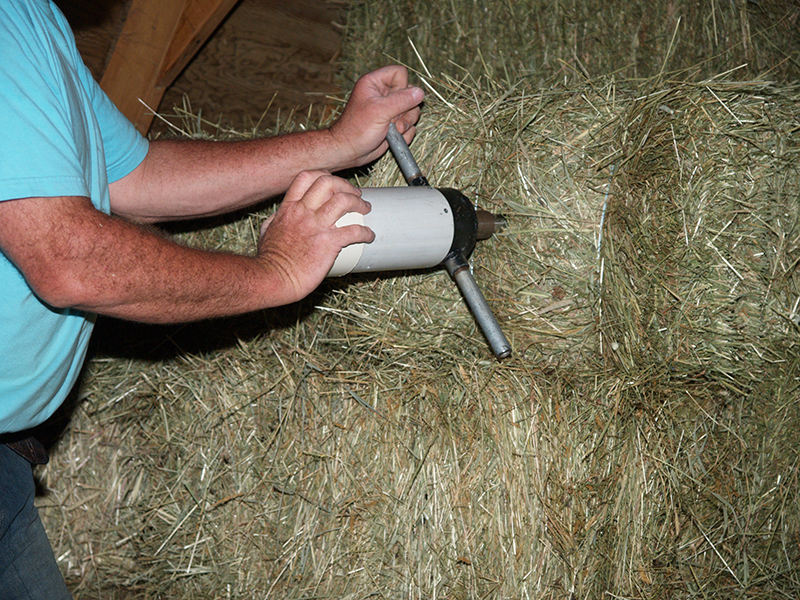
A water soluble carbohydrate (WSC) analysis result on your hay of more than 10 to 12 percent can indicate a high level of the complex polysaccharide, fructan. Feeding large quantities of high fructan hay can result in potential hind gut problems. Photo: Pam MacKenzie Photography
Horses with PSSM need to have a largely starch and sugar free diet and instead rely on hindgut fermentable fibre sources such as beet pulp and/or soy hulls, alfalfa hay, low WSC (less than 10 percent) grass hays, and fat sources for energy. High performance horses with PSSM can be especially challenging to feed and the tried and true management practice of small meals fed often becomes very important.
Does my horse need a low starch diet?
One only has to peruse the internet briefly to be bombarded with advice on feeding our horses and the low starch diet is frequently advised as the answer for everything from laminitis to skin issues. In order to accurately determine if your horse would benefit from a low starch diet you need to objectively assess your riding and performance goals.
If you have a high performance horse that is working hard, you may well need to include starch in his diet for optimum success. Feeding a high starch diet to this type of horse can be advantageous but management of feeding and meals becomes more important.
If you have a performance horse with a metabolic disorder such as PSSM, you should talk to your veterinarian or equine nutritionist about designing a low starch diet for your horse that will provide him with sufficient digestible energy to meet his performance goals without compromising his health.
Remember the impact of forage in your horse’s diet. Horses that are mature, healthy, and engaged in light work probably don’t need much more than good quality hay and a vitamin and mineral supplement, and may even need to be on a diet that limits intake for best health. Even a low starch diet, if providing calories that are in excess of your horses’ needs, will not be helping him live a long and happy life. Don’t forget the importance of exercise for a healthy metabolism in your horse. Consider consulting a veterinarian or equine nutritionist to assist in formulating a sound ration to help your horse live a long, healthy, happy life.
Main photo: Robin Duncan Photography - A high performance horse often requires starch in the diet; it can be challenging to formulate a diet for the competition horse which has a metabolic disorder, such as PSSM.







